As an edtech company competing in an industry that’s projected to reach $605 billion by 2027, it’s crucial to not only capture the attention of your target audience but also convert them into loyal customers. With the ever-increasing competition, marketing teams often wonder how to create campaigns that resonate, engage, and deliver tangible results.
Enter email marketing–a proven, cost-effective strategy boasting an impressive ROI of $36 for every $1 spent. But how can you leverage this powerful tool in a way that speaks directly to the educators, institutions, parents, and learners who make up your audience?
In this comprehensive blog post, we’ll guide you through building an email marketing strategy tailored to the EdTech sector’s unique challenges and opportunities. From understanding your audience’s pain points to crafting personalized content that speaks to their needs, we’ll provide actionable insights to help you drive growth and forge lasting connections with your target market. By the end of this article, you’ll be equipped with the knowledge and tools needed to skyrocket your conversions and make a lasting impact in the fast-paced world of edtech.
So let’s get started, and unlock the full potential of your email marketing efforts!
6 Key Steps To Building An Impactful Email Marketing Strategy For Edtech
A robust email marketing strategy empowers you to actively engage with your target audience, cultivate trust and credibility, and ultimately elevate your conversion rates. By implementing these six time-tested steps, you can construct a compelling email marketing plan that nurtures deep relationships with your audience and drives you toward achieving your business objectives.
1. Identify your ideal customer and create buyer personas
In the diverse landscape of the EdTech industry, it’s vital to recognize your audience’s unique needs, interests, and goals. Customizing your email content to cater to their specific requirements lays the foundation for building strong, meaningful relationships.
Begin by comprehensively understanding your target audience, which encompasses demographic data (age, gender, location, and profession) and psychographic insights (goals, challenges, and pain points). Utilize various methods to gather this information, including market research, surveys, and customer feedback.
Armed with this knowledge, craft well-defined buyer personas—essential for a successful email marketing strategy. Remember that as an EdTech company, you may have multiple personas, such as teachers, administrators, students, and parents, each possessing distinct needs and interests. By identifying these personas and developing content that connects with them, you can establish credibility and trust in the EdTech space.
Here is an example of what your ideal buyer persona of a graduate student would look like.
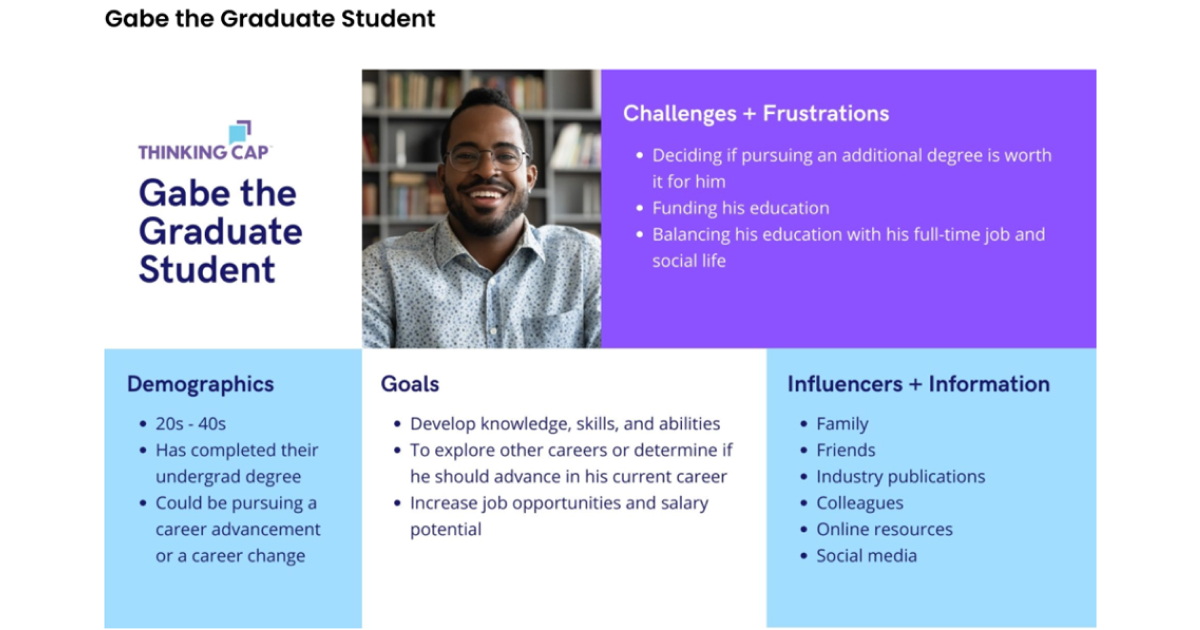
| Name | Demographics | Pain Points and Challenges | Goals and Aspirations | Influencers |
|---|---|---|---|---|
| Dhruv | Age: 25 | Limited time to study due to a busy academic schedule and part-time job commitments. | Successfully complete a Master’s degree in Computer Science with a strong GPA. | Professors and teaching assistants |
| Gender: Male | Struggling to grasp complex concepts without personalized guidance or support. | Acquire practical skills and knowledge that will enhance employability and industry relevance. | Family members | |
| Location: Urban area | Balancing schoolwork, personal life, and professional development. | Build a professional network within the tech industry. | Friends and peers | |
| Occupation: Full-time graduate student in Computer Science | Staying motivated and focused on long-term academic and career goals. | Land a competitive job or internship in a reputable tech company. | Social media | |
| Annual Income: N/A (dependent on parents and student loans) | Difficulty finding quality, affordable resources to supplement university courses. | Pursue lifelong learning and stay up-to-date with the latest trends and advancements in the field. | Online resources |
The more detailed your buyer personas, the better equipped you’ll be to tailor your email content to their specific pain points. By delivering targeted content that speaks directly to each persona, you’ll facilitate stronger connections with your audience, ultimately boosting conversions.
2. Define your EdTech email marketing goals
Establishing clear and measurable goals is a crucial step in constructing an impactful email marketing strategy for your EdTech business. By defining your objectives, you can align your email campaigns with your company’s overarching mission and monitor progress more effectively.
When setting your email marketing goals, consider key performance indicators (KPIs) such as open rates, click-through rates, conversions, and overall engagement. Additionally, contemplate qualitative objectives such as building brand awareness, nurturing customer relationships, and positioning your company as a thought leader in the EdTech space.
For example, your goals could include increasing course enrollments, boosting webinar attendance, or driving traffic to your latest blog posts. Ensure that your goals follow the SMART criteria—Specific, Measurable, Achievable, Relevant, and Time-bound—to set the stage for a successful email marketing campaign.
As you define your goals, keep your buyer personas and their specific needs in mind. By aligning your objectives with your audience’s interests and pain points, you can create email content that resonates with them and drives meaningful engagement, ultimately propelling your EdTech business toward success.
Here is an example of Code School, an EdTech platform specializing in offering coding courses, which effectively utilizes email marketing to generate leads. By offering complimentary access to their extensive content library for a limited time, they enticed potential customers to explore their platform and experience the value firsthand.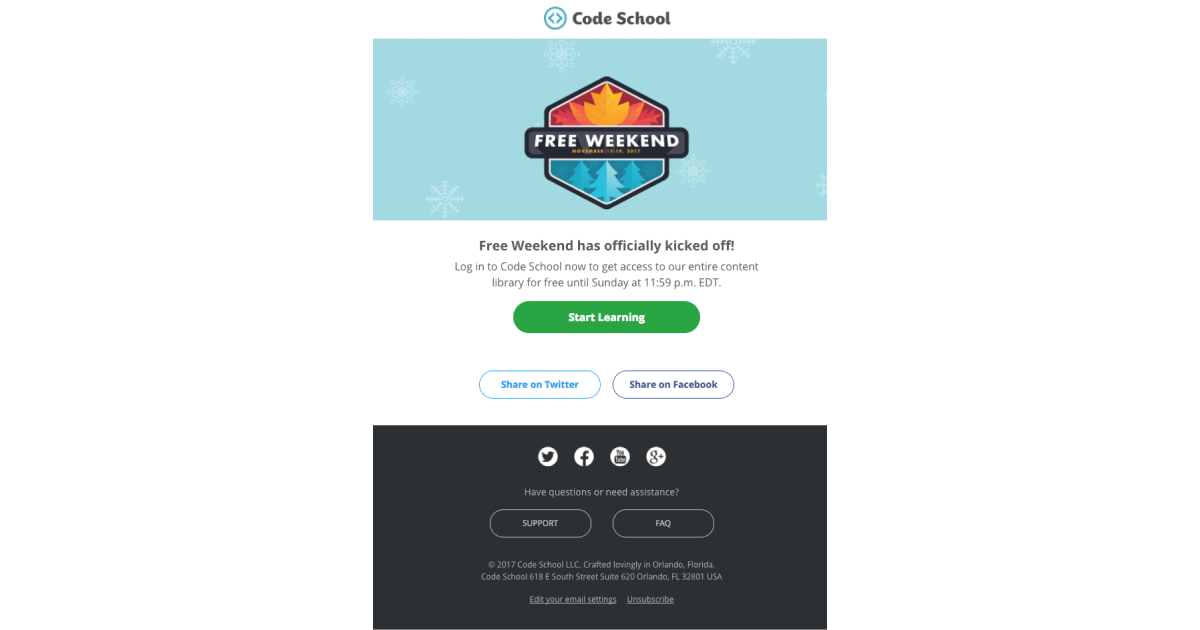
This approach encouraged users to log in to Code School within the designated time frame, simultaneously capturing their interest and generating valuable leads. As a result, Code School could successfully expand its user base and position itself as a leading provider of coding courses.
3. Craft engaging content for your emails
Developing captivating and valuable content is essential for the success of your email marketing strategy. Producing content that meets your audience’s needs, interests, and aspirations can cultivate stronger connections and drive desired actions, such as enrollments, event registrations, content consumption, and engagement.
For instance, AllRound, a global EdTech platform focused on making co-curricular learning fun for kids, realized the importance of engaging working parents to provide value to their young learners. To improve customer engagement through email, they created visually appealing and interactive emails with feedback forms and polls. This approach resulted in 28% responses on feedback forms and 14% poll responses, driving AllRound’s goal of increased customer engagement and enabling parents to stay informed about new initiatives while offering feedback seamlessly.
To craft engaging content for emails, consider the following tips:
- Personalize: Address recipients by their names and tailor content to their specific buyer personas. Personalization helps establish rapport and demonstrates that you understand their unique needs and interests.
- Provide value: Offer practical insights, actionable tips, or exclusive resources, such as lesson plan templates for teachers, study guides for students, or parent guides for navigating online learning platforms. These valuable resources can enrich your audience’s learning experience and address their pain points.
- Be concise and clear: Use simple language and straightforward messaging to convey your ideas. Avoid educational jargon and ensure your content is easy to understand and digest for a diverse audience, including those who may be new to the concepts you share.
- Incorporate visuals: Leverage images, infographics, or GIF that showcase educational tools, demonstrate platform features, or explain complex concepts in a digestible format. This approach will break up text and create a visually appealing email that captures your audience’s attention while also enhancing their understanding of your content.
- Include clear calls-to-action (CTAs): Guide your readers towards the desired action with compelling and easily identifiable CTAs, such as “Sign Up Now” or “Download Your Free E-book.”
As you create content for your emails, remember to maintain consistency in your brand voice and messaging across all communications. By doing so, you’ll build credibility, trust, and familiarity with your audience, ultimately contributing to the long-term success of your email marketing strategy.
4. Structure and optimize your email campaigns
A well-structured email campaign is vital for ensuring a smooth and impactful communication experience with your audience. By organizing your email campaigns, you can maintain consistency, improve deliverability, and optimize engagement, ultimately driving better results for your business.
To structure your email campaigns effectively, consider these key steps:
- Segment your audience: Divide your subscribers into smaller groups based on the buyer personas you created, such as teachers, administrators, or students. This allows you to send targeted content, such as professional development resources for teachers or study tips for students, catering to each segment’s specific needs and boosting engagement and conversions.
- Plan your email frequency and timing: Establish a balanced email schedule to maintain regular communication without overwhelming your audience. Consider factors such as school holidays, exam periods, or back-to-school seasons when planning your campaigns to maximize engagement.
- Create an email content calendar: Outline your content plan, including topics (e.g., upcoming webinars, course updates), formats (e.g., newsletters, announcements), and CTAs (e.g., “Enroll Now,” “Download Free Resource”). This will ensure consistency and alignment with your marketing goals and help you identify opportunities for cross-promotion and collaborations.
- Test and optimize: Employ A/B testing and analytics to identify the most effective subject lines, content, and design elements for your audience. Continuously refine your campaigns based on data-driven insights to improve open rates, click-through rates, and overall engagement.
- Monitor and analyze: Track your email campaign performance regularly and make necessary adjustments to achieve your desired outcomes. Utilize metrics such as open rates, click-through rates, and course enrollments to gauge success and identify areas for improvement.
By carefully structuring your email campaigns, you can enhance the effectiveness of your communications, facilitate meaningful relationships with your audience, and achieve your email marketing goals.
This flowchart illustrates the process of structuring EdTech email marketing campaigns, guiding you from the initial welcome series to the final feedback emails. It highlights the essential steps, including onboarding new subscribers, engaging them with tailored content, promoting relevant offerings, and gathering valuable feedback. By following this comprehensive roadmap, you can effectively nurture and convert your audience.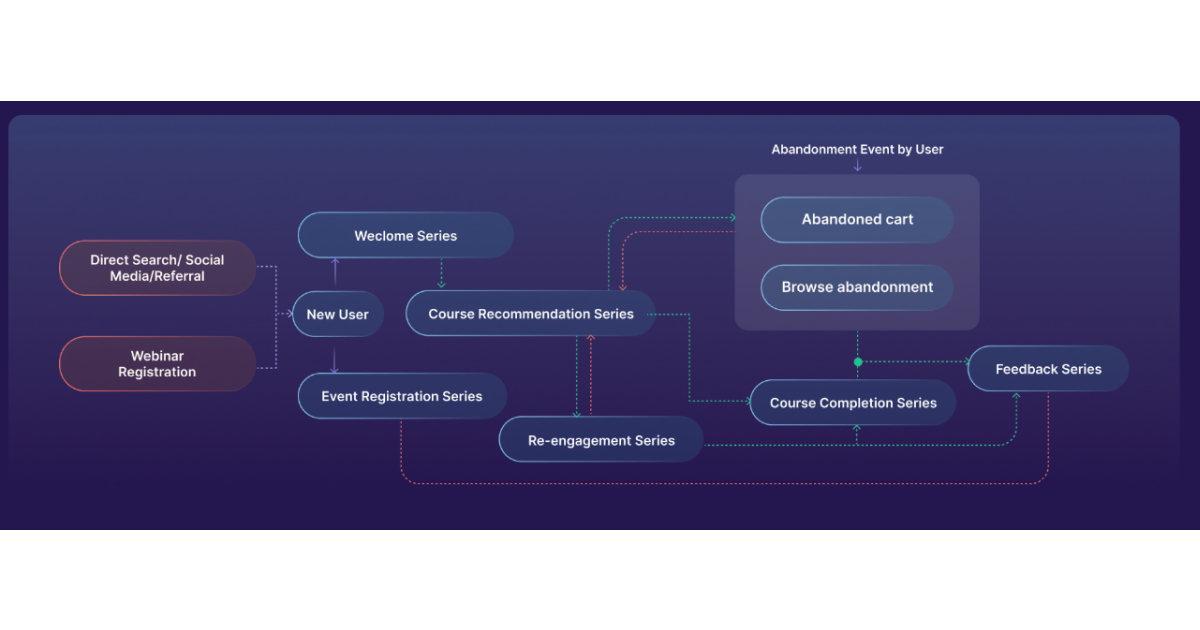
Various forms of email campaigns to leverage:
Welcome email campaigns
Welcome emails play a pivotal role in establishing a strong connection with new subscribers or learners. By creating personalized, value-driven welcome emails, companies can nurture a positive sentiment, build trust, and set the stage for successful long-term relationships.
For example, in the email below, edX welcomes the learner by highlighting the impressive community of 16 million peers and establishing a confident rapport. In addition to showcasing prestigious names and institutions to learn from, edX also extends a discount offer for certifications, further enhancing the email’s appeal and value for the recipient.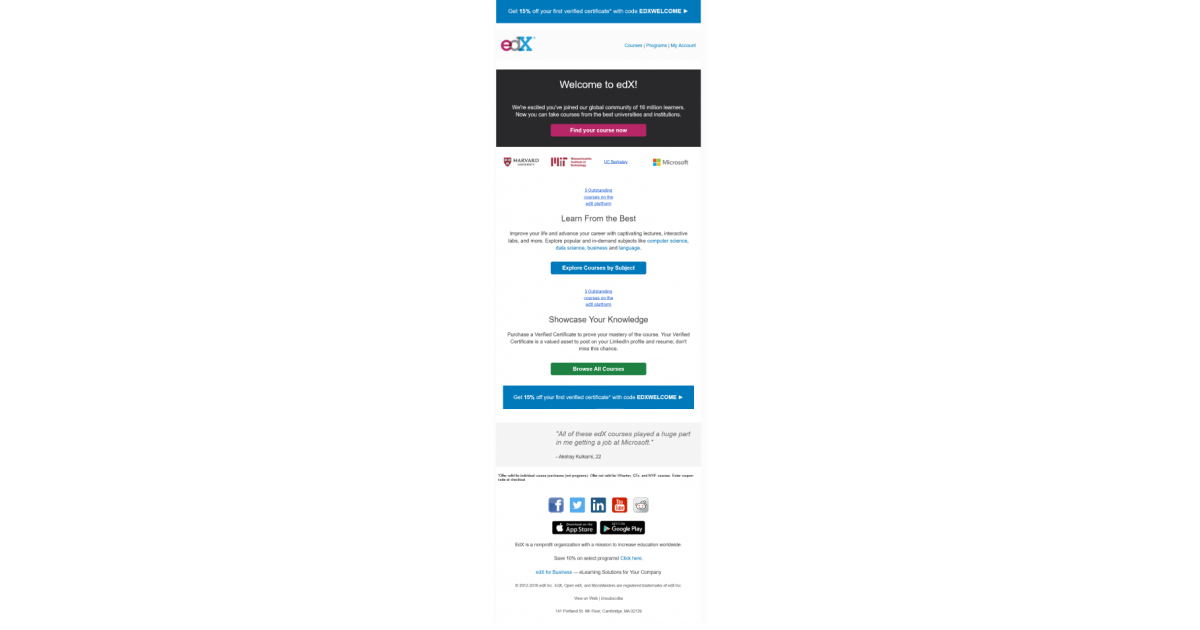
Newsletters
Newsletters can be a powerful tool for edtech brands, enabling you to showcase valuable content, promote your new courses, and maintain engagement with your audience. Creating well-designed, focused newsletters can effectively drive course enrollments, encourage repeat purchases, and foster long-term relationships with your subscribers.
A prime example of this approach is evident in one of Udemy’s newsletters. The company chose to highlight current trending courses on their platform, along with top categories of courses, with the intent of boosting enrollments and purchases. The clean design of the email, which focuses solely on promoting the courses, ensures that the message is clear and compelling to the reader.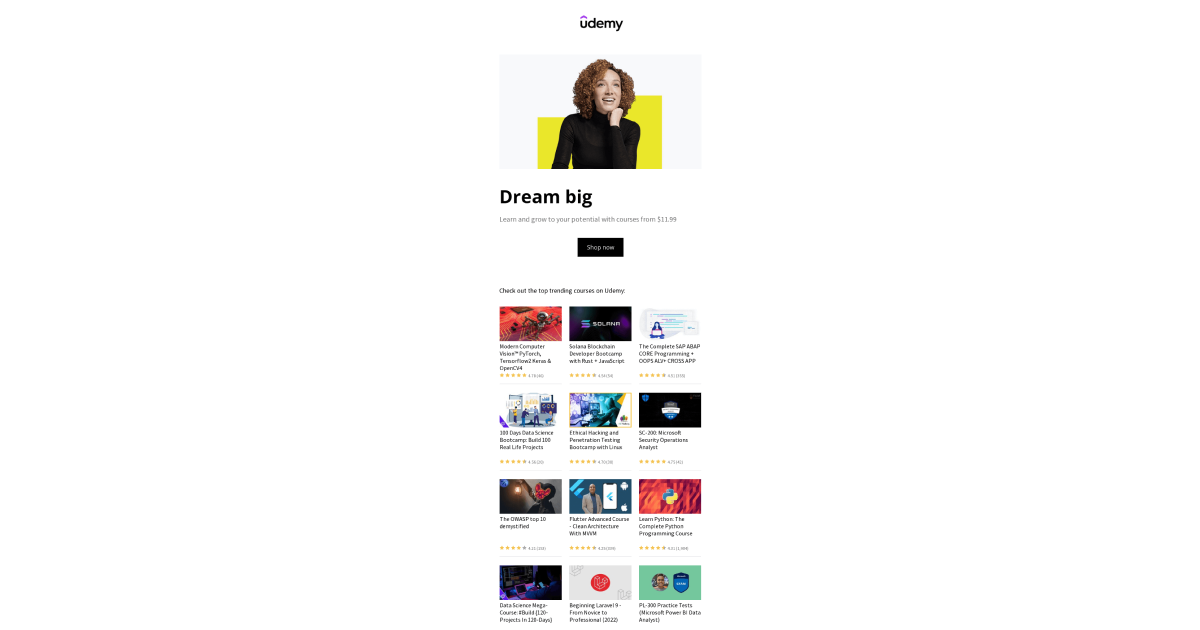
Promotional offers
Promotional emails can be a highly effective tool for EdTech brands to drive interest, increase enrollments, and boost revenue. By creating compelling offers, showcasing the value of your products or services, and using persuasive messaging, you can significantly enhance the success of your promotional campaigns and capture your audience’s attention.
Here is an example from Codeverse, the world’s first interactive coding studio and an EdTech platform founded with the mission to teach a billion kids to code. In one of their promotional campaigns, Codeverse offered a code that users could apply to receive a $200 discount on their weekly summer camps.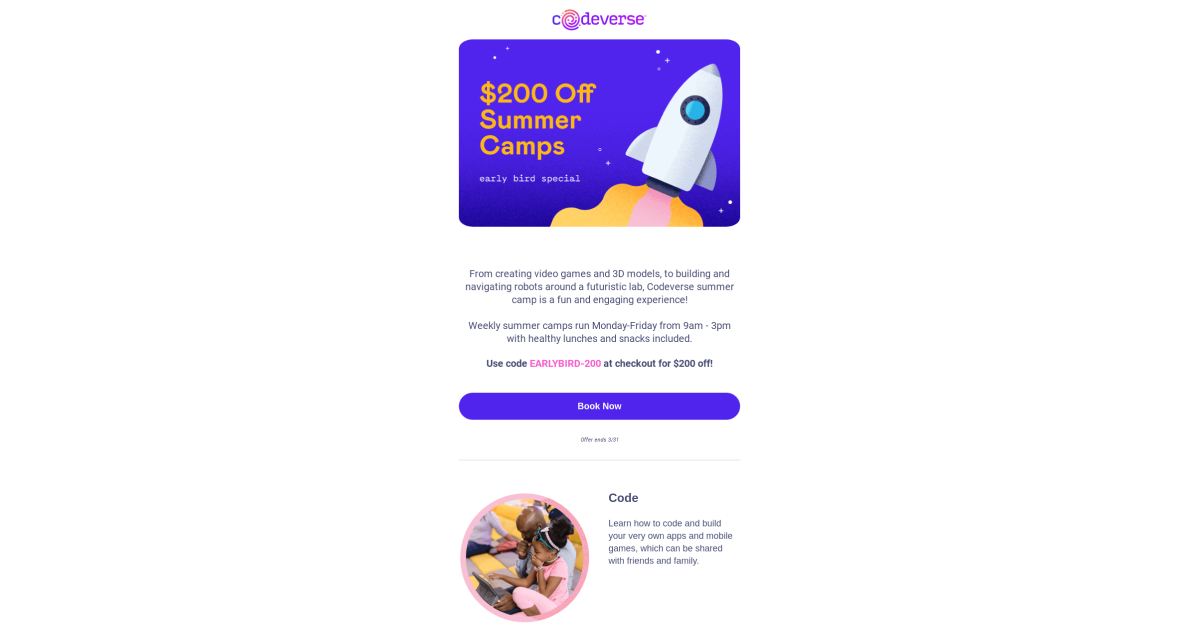
By offering this discount, they captured their audience’s attention and created a sense of urgency, encouraging more enrollment and new sign-ups.
Educational content and tips
Sharing educational content and helpful tips through email campaigns is an effective way for EdTech brands to establish expertise, provide value to the audience, and foster trust. By offering practical advice and actionable strategies, you can demonstrate your commitment to your customers’ success while subtly promoting your products or services.
Here is an example of Babbel, a German subscription-based language-learning software and e-learning platform available in various languages. In one of their emails, Babbel provides valuable tips on learning languages. This demonstrates its expertise in the field and establishes itself as a reliable and knowledgeable source for users.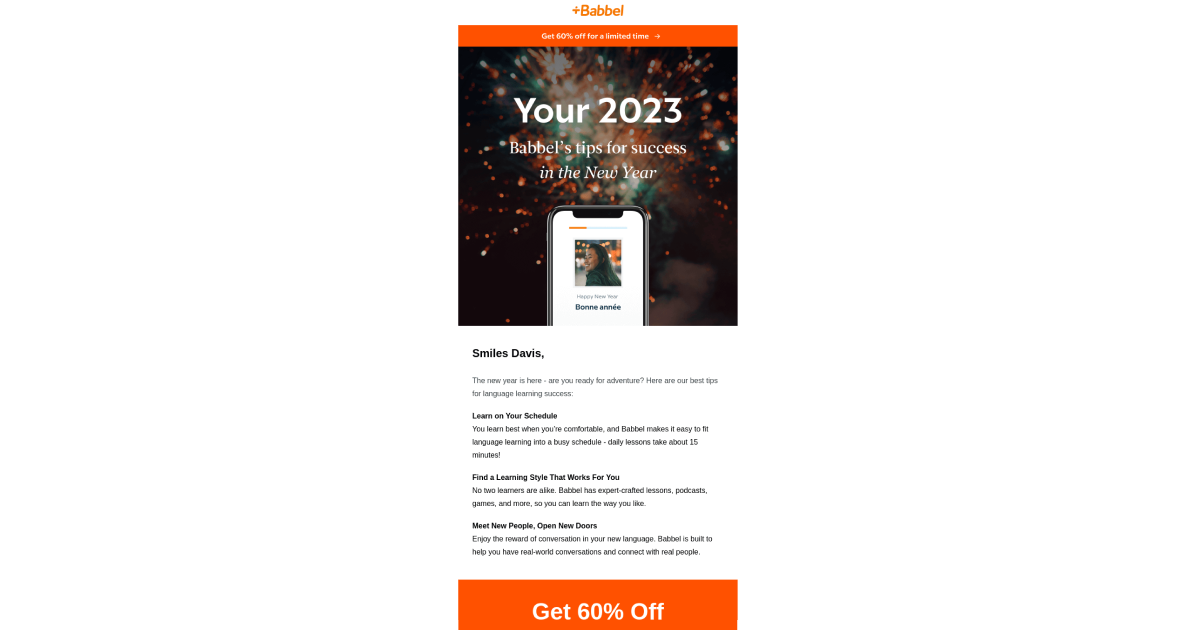
This trust-building approach creates a strong foundation for promoting their platform and its benefits. By subtly weaving their offer of a 60% discount into the email, Babbel entices potential customers to explore their subscription-based e-learning platform further.
Re-engagement campaigns
Re-engagement email campaigns are a crucial strategy for EdTech brands to reignite interest among inactive or disengaged subscribers. By showcasing new or trending content, offering special promotions, and highlighting the value of your offerings, you can recapture your audience’s attention and encourage them to re-engage with the platform.
Here is an example of a successful re-engagement email from Skillshare, an online learning community. In their email, Skillshare features six popular courses and four fast-trending projects, enticing subscribers with the latest and most relevant content. To further encourage engagement, the email offers a free 14-day trial, allowing users to explore the platform without any upfront commitment. Additionally, Skillshare emphasizes the platform’s cost-effectiveness and value by mentioning the affordable monthly cost of just $8.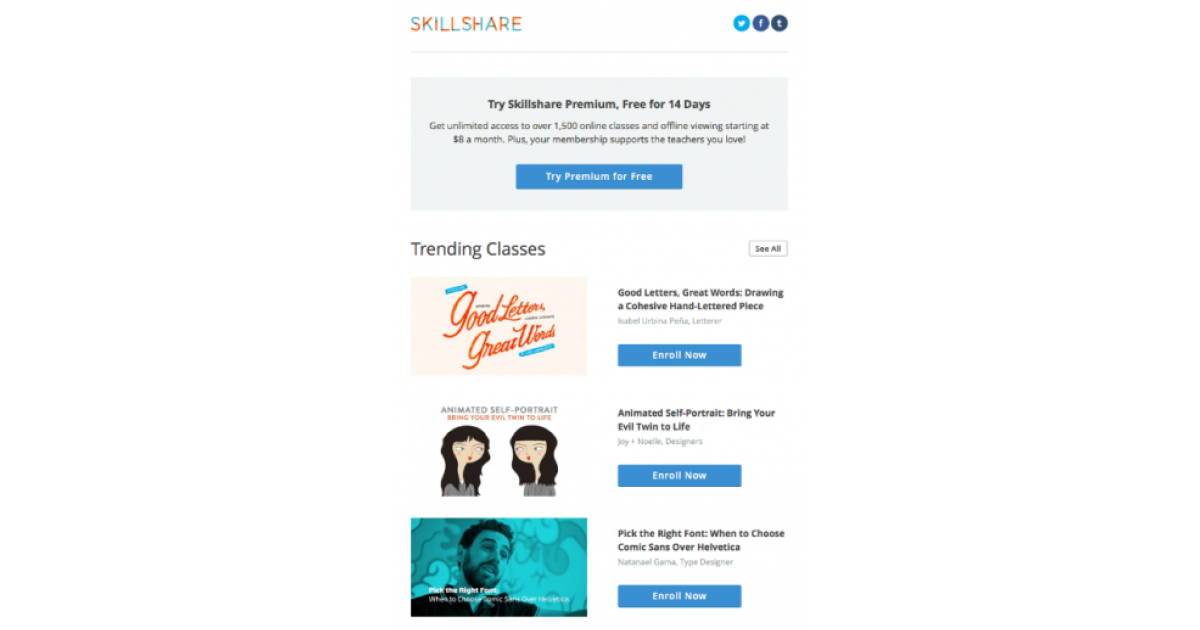
5. Build and maintain a healthy email list
Nurturing and maintaining a healthy email list is crucial for your email marketing strategy because a well-curated list guarantees that your messages reach an interested and responsive audience, leading to higher engagement, conversions, and business growth.
You can begin by organically expanding your email list through various avenues, such as your website, social media channels, and collaborations with other organizations. Offer valuable assets like ebooks, webinars, or exclusive promotions to motivate potential subscribers to join your mailing list. However, adhering to General Data Protection Regulation(GDPR) is essential to maintain a healthy list and avert potential legal issues.
Additionally, you must regularly assess and cleanse your email list to eliminate inactive or disengaged subscribers and those who have unsubscribed or provided invalid email addresses. This approach enhances your email deliverability and open rates and helps you avoid being flagged as spam or penalized by email service providers.
Segmenting your email list based on criteria such as buyer personas, interests, and engagement levels is another vital aspect of maintaining a healthy list. This enables you to send tailored, pertinent content to each segment, increasing engagement and nurturing stronger relationships with your subscribers.
By dedicating time and effort to building and maintaining a healthy email list, you can optimize the impact of their email marketing efforts, leading to improved customer loyalty, increased conversion rates, and, ultimately, long-term success.
6. Leverage marketing automation
In the fast-paced EdTech industry, leveraging marketing automation can be a game-changer for your email marketing strategy. By automating repetitive tasks and streamlining processes, you can save time, enhance efficiency, and focus on creating high-quality, targeted content that appeals to your target market.
For instance, UniConnect by Leverage Edu, the world’s first and largest online university fair platform, adopted WebEngage’s marketing automation platform to engage students in a timely and effective manner. This resulted in increased student attendance for online education fairs and saved 2.5x human hours by automating informational campaigns about universities, fees, and scholarships.
Marketing automation enables your brand to set up automated email workflows that guide subscribers through a personalized journey based on their behavior, preferences, or stage in the sales funnel. It helps identify and nurture high-potential leads with targeted content and timely communication. Additionally, it streamlines the process of identifying disengaged subscribers and sending them targeted re-engagement campaigns to reignite their interest in your platform.
By leveraging marketing automation in your EdTech email marketing strategy, you can create more personalized, relevant, and timely communications that drive engagement, boost conversions, and enhance your overall marketing effectiveness.
Conclusion
Crafting a compelling and effective email marketing strategy is paramount for EdTech companies looking to connect with their audience, build trust, and drive conversions. By following the steps outlined in this blog, you can create a powerful email marketing campaign that connects with your target market, addresses their unique needs and aspirations, and ultimately propels your business to new heights.
As you embark on this journey, it’s essential to have the right tools at your disposal. WebEngage, a comprehensive email marketing platform, can be your go-to resource for designing and automating email drip campaigns throughout each stage of the customer journey.





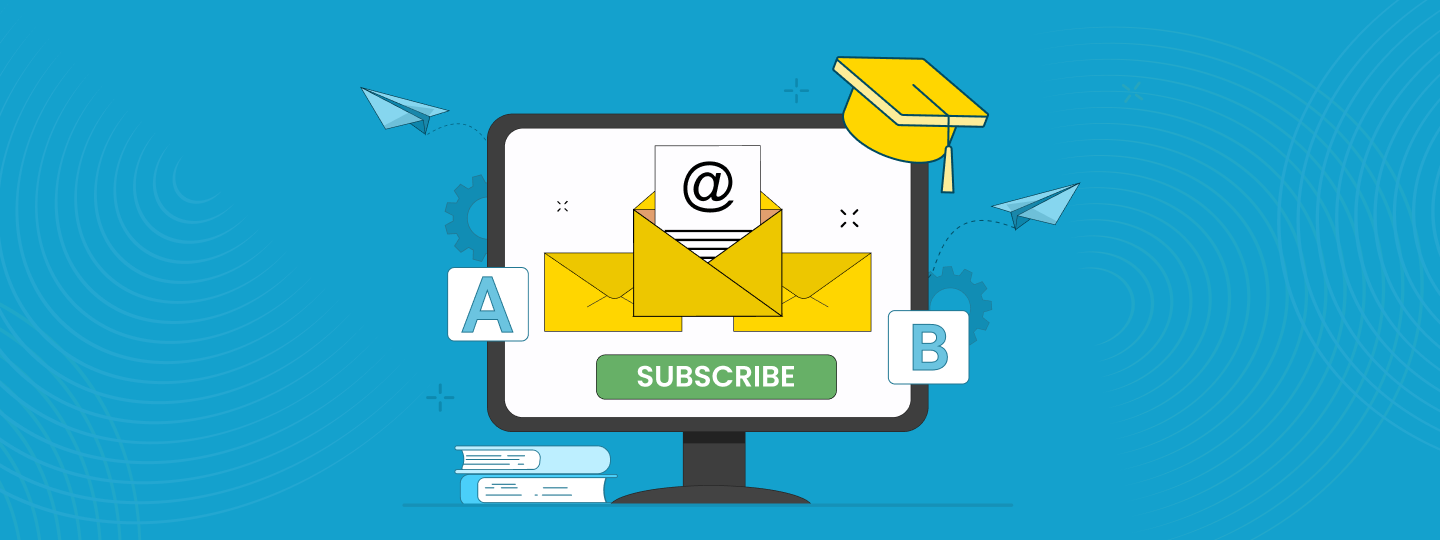

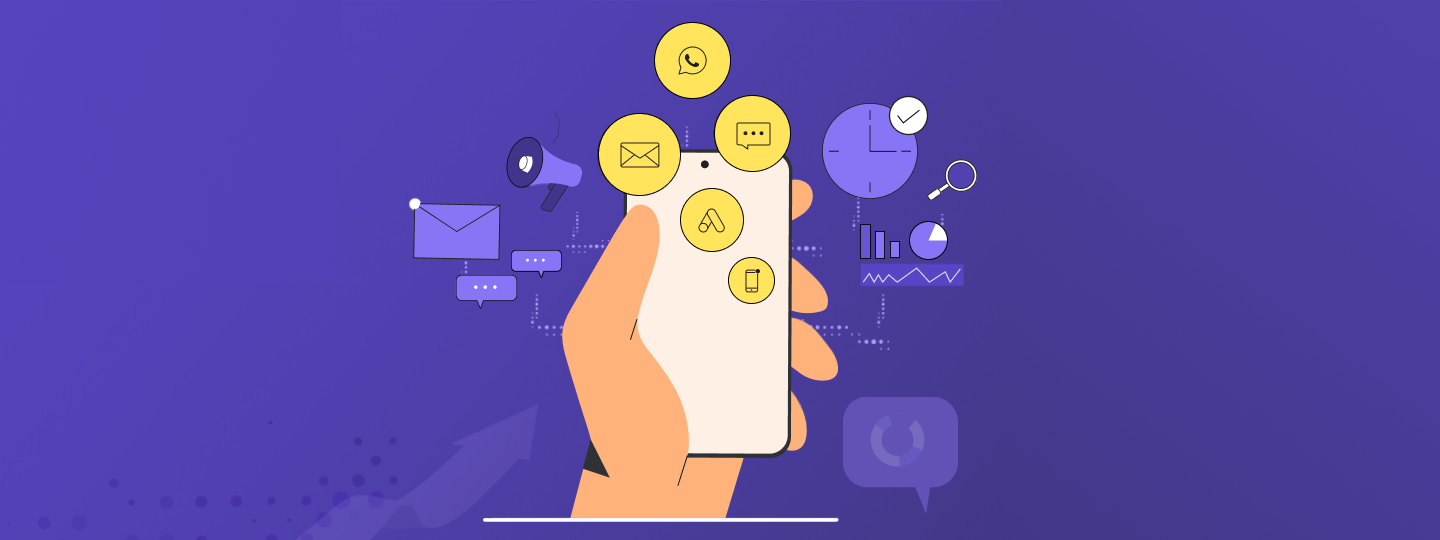
 Inioluwa Ademuwagun
Inioluwa Ademuwagun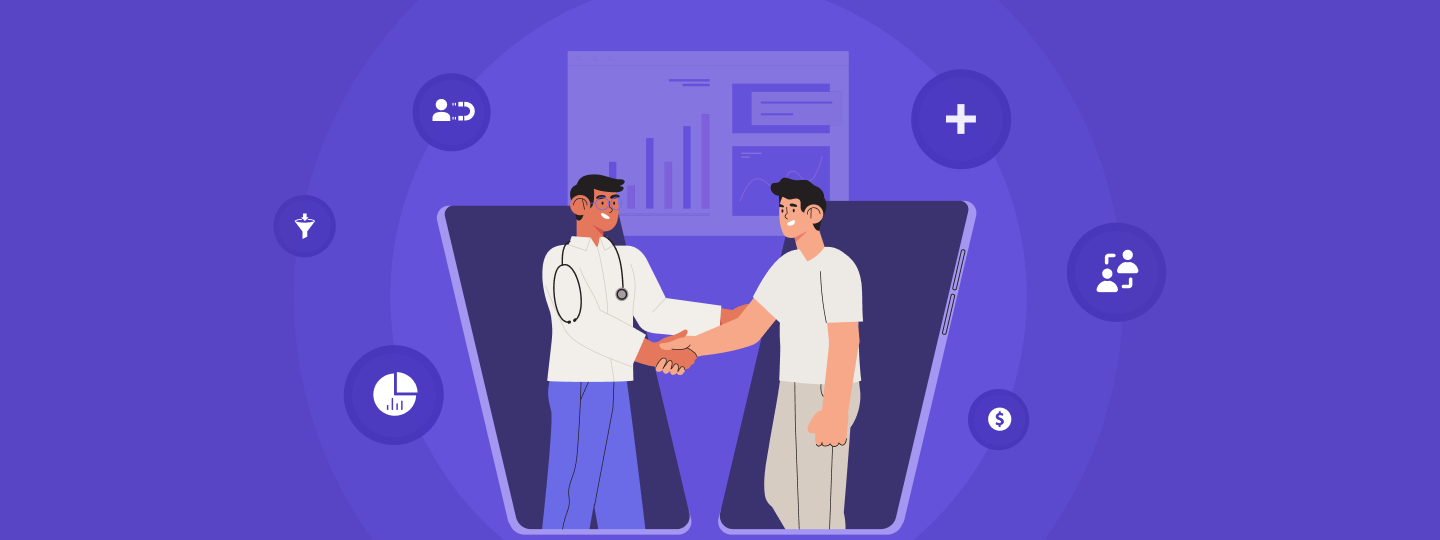

 Vanhishikha Bhargava
Vanhishikha Bhargava